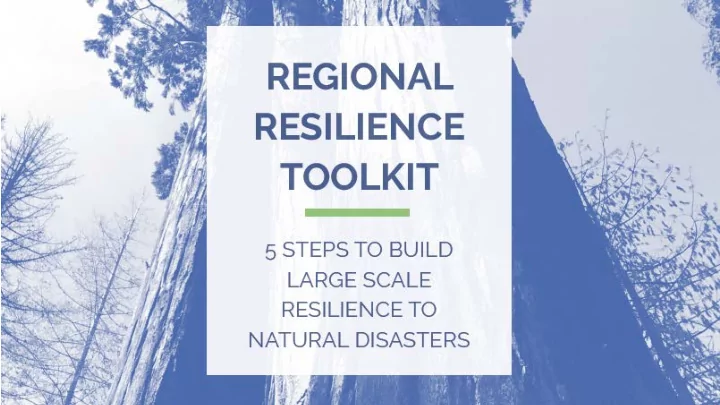

Da David Do Doyle U.S. Environ onmen ental P Prot otection on A Agency Re Region 7 7 doyle.david@epa.gov 913-551-7667
Toolkit is online at: www.epa.gov/smartgrowth/regional- resilience-toolkit
Resilience i is about b building t the c capacity o of the com ommunit ity, at t vario ious s scales, t , to o prepare f for, , withstand, r recover, a and maintain i its identity i in t the face ce of of a actu ctual or l or anticip icipated h hazard occu occurrences, allowin ing f for or c con ontin inuity of of com ommunity a and q quick rec ecovery i if a disaster o occu ccurs.
Partnership between EPA & FEMA • Sets up coordination of activities between EPA's sustainable communities, smart growth, environmental, and community technical assistance programs and FEMA's disaster recovery planning and hazard mitigation programs. • Seeks to provide lessons learned for EPA, FEMA, and other federal agencies that can be used to build a stronger federal framework for mitigation planning as well as pre- and post-disaster recovery planning and operations. • Seeks to provide a collaborative framework for policy work related to both hazard mitigation planning and climate change adaptation to create more resilient communities.
Goals of the Toolkit • Emphasize the need for action, not process, to move the needle on resilience-building (including a whole step on funding). • Helps cities, regions and other partners integrate various planning processes into a single process to create a common action plan. • Coordinates local action to amplify disaster resilience within a regional context.
Quick Overview of the Toolkit • Regional scale is key. Works across multiple cities over a large geographic region • Recognizes local authority for implementing plans and spending funds • Aligns with different plan requirements • FEMA Local Hazard Mitigation Plan requirements • Addresses different hazards • Applies to different assets
STEP 1: ENGAGE • Best Practices for Building Trust • Importance of Equity • Establish a Common Vocabulary • Stakeholder Mapping • Engagement & Outreach Plans • Meeting Roadmap
STEP 2: ASSESS • Figure Out Your “Trigger” • Set Resilience Goals • Describe Hazards • Develop Hazard Impact Statements • Prioritize Hazards • Select Assets • Determine Assessment Method • Create Profile Sheets
STEP 3: ACT • Summarize Vulnerability • Develop Strategies • Evaluate & Prioritize Strategies • Identify Catalysts for Implementation • Political Buy-In • Develop Implementation Plans
STEP 4: FUND • Make the Business Case for Resilience • Build Your Funding Network • Identify Self-Reliant Financing • Set Up a Resilience Finance Menu • Public-private financing • Philanthropic and corporate grants • Regional funding programs • Federal and state grants
STEP 5: MEASURE • What to Measure and Why • Outputs vs. Outcomes • Self-Evaluation • Measure and Refine
Two Appendices • Appendix A has a list of specific outcomes to expect and other groups’ resources for each step. • Appendix B has worksheets to walk project teams through the five steps.
How to Use the Toolkit • This Toolkit can be used by regional partnerships and local jurisdictions just starting to plan for resilience, or by those ready to move from planning to action. • States may want to use the Toolkit across several regions to take on large-scale disaster risk. • EPA & FEMA (and other feds) could provide direct support and attend workshops with regional teams.
Next Steps • Toolkit is online at www.epa.gov/smartgrowth/regional-resilience- toolkit • If interested in using this toolkit in your state or region, contact Abby Hall at EPA about setting up a meeting with your EPA and FEMA Regions to talk about next steps. Abby Hall hall.abby@epa.gov (202) 631-5915
Recommend
More recommend